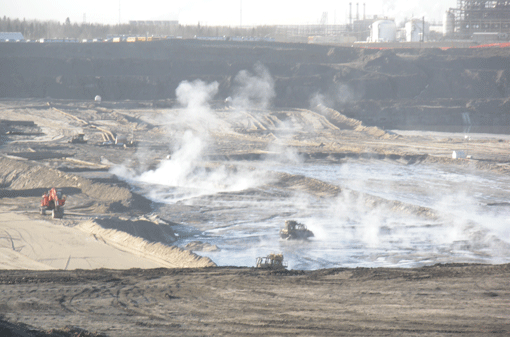With his decision on November 10 to review the route of the Keystone XL pipeline—and delay a final determination on whether to give the green light—President Obama had likely wished that the issue would not surface again until after the 2012 elections. But politics are not so easy, especially when it comes to this 1,700-mile long project that would carry 800,000 barrels per day of heavy crude oil from Alberta, Canada, to Oklahoma and the Gulf Coast. To put it in perspective, that amount is about half of what the U.S. imports from the Middle East.
This week, the Keystone XL pipeline is yet again taking center stage. Republicans in the House of Representatives are threatening to hold hostage the president’s top legislative priority for December—extension of the payroll-tax cut and unemployment insurance—unless the package includes a provision that would move the decision making over the pipeline from the State Department to the Federal Energy Regulatory Commission and shorten the period in which a decision must be made. Obama’s response came yesterday after a meeting with Canadian Prime Minister Stephen Harper: “Any effort to try to tie Keystone to the payroll-tax cut, I will reject.”
Get ready for a showdown. On Thursday, the House leadership announced that the vote will occur next week.
But why is Keystone XL such a political hot potato? Other pipelines already bring Canadian oil into the United States, although not in the quantity that Keystone XL would. For one, Nebraska legislators and environmentalists worry that the proposed route could endanger the Sand Hills region wetlands and the Ogallala Aquifier, which is an important source of drinking water, if any leakage were to occur. TransCanada, the Canadian pipeline company responsible for the proposed project, has said it would look to find an alternate route.
Still, many would not embrace Keystone XL even if the perfect route were chosen. Beyond the pipeline, there is a fundamental rejection of importing Canada’s oil due to concerns over the environmental impact of its extraction.
I recently traveled to Canada’s oil sands—located in northern Alberta—for an on-the-ground perspective of the industry. One thing was clear: the industry is massive, and at current oil prices, extraction in Alberta will only continue to expand, with or without Keystone XL.
The sheer geographic size of the oil deposits is immense, representing 21 percent of the province, or approximately the size of Florida. Of that, extraction is currently taking place in an area that would encompass all of Rhode Island.
Comparatively, Alberta’s oil reserves (171 billion barrels established) rank it as number three globally—behind Saudi Arabia (260 billion) and Venezuela (211 billion). And while industry experts won’t speculate on how much more oil could be profitably extracted if world oil prices were to increase, the amount of oil that is recoverable in Alberta today is only 10 percent of what is beneath the ground.
So Canada—the largest supplier of crude oil and petroleum products to the U.S. today—has the potential to help fill the gap in any declining supply from Mexico and Venezuela and to reduce U.S. dependence on oil from Saudi Arabia.
But Canadian oil is different and that’s a primary source of the opposition to its extraction. The oil sands are a mixture of sand, water, clay, and bitumen (heavy oil that must be diluted or heated before it can flow or be pumped). And with that comes carbon dioxide emissions that—according to Cambridge Energy Research Associates—are 6 percent more intensive than the U.S. crude supply average on a wells-to-wheels basis, or from the start of production through combustion. Other estimates place it higher.
And beyond the greenhouse gas emissions, pictures of the land devastation caused by the mining of the oil sands are a rallying cry against them.

Mining complete and now time for land reclamation, November 2011. Photo courtesy of the author.
But things are changing. For one, mining is slowly being replaced by steam assisted gravity drainage draining (in situ)—a method that injects steam or other sources of heat into the ground to pump out bitumen located more than 200 feet below the ground. In 2010, mining accounted for 53 percent of oil sands production while in situ represented 47 percent. It is likely that the two methods will have a roughly equal share of the oil production this year. And looking forward, in-situ growth may very well outpace that of mining; of the total recoverable resources in the oil sands, 80 percent will have to be extracted using in-situ techniques.
In comparison to mining, in-situ mining results in minimal damage to the land surface as one drilling well can support multiple below-ground pipes. For in-situ mining, the key challenge is reducing the steam-to-oil ratio (barrel of steam/barrels of oil) to below 2.0 in order to decrease emissions and water and energy usage to a level that would make the process more environmentally friendly. Industry has a stake in accomplishing this. Beyond the environment, this would significantly reduce operating and capital cost.
Of course, additional concerns exist around the Canadian oil sands: the effects on land, on water, on Alberta’s First Nations people, and on wildlife, among others. None of these topics should be dealt with lightly, and the government and private sector are working to address them. (Stay tuned for a follow-up post that looks more in-depth at these concerns.)
But the central point is that Canada’s oil sands are here to stay. With the Keystone XL delay, Canadian officials are now ramping up their efforts to feed energy-hungry Asia.
Kinder Morgan operates the 715-mile Trans Mountain pipeline, which carries up to 300,000 barrels of crude and refined oil daily to Burnaby, British Columbia, where 17 percent is then loaded onto Asia-bound tankers. And it is also seeking approval of the Northern Gateway pipeline, which would carry 525,000 barrels per day to the northern British Columbia coast for export to Asia—a government decision is not expected until 2013.
Energy independence is a widely shared goal. So rather than push Canada to look for more routes to export its oil to Asia, the Keystone XL discussions represent an opportunity for greater U.S. engagement with Canada and with Alberta’s provincial government on addressing concerns around the oil sands. Some of which will increasingly lose relevance as extraction techniques advance.
With the world’s unquenchable thirst for oil, like it or not, Canada’s oil sands are here to stay—and to grow.
*Jason Marczak is a contributing blogger to AQ Online. He is senior editor of Americas Quarterly, managing editor of AQ Online and director of policy at the Americas Society and Council of the Americas.




